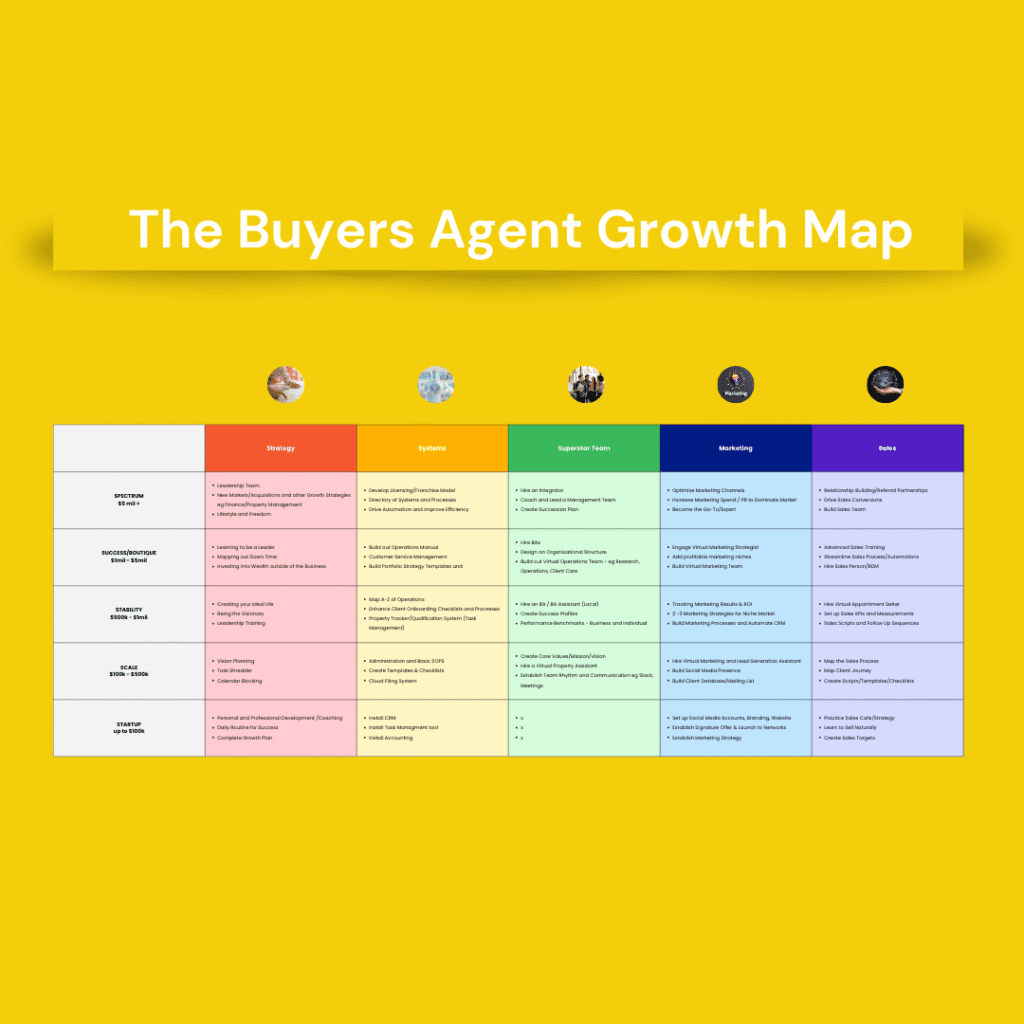Any property buyers agency aims for scaling and growth. The promise of stability on this line of business is both attractive and intimidating.
But with the right business growth plan, that stability and success will be an exciting experience just on your fingertips.
Here’s the thing: A good business strategy for growth begins by defining where your buyers agency business is in its journey.
Do you have a startup business? A scaling one? A stable agency? Or a bigger successful one, aiming to stay in the spectrum?
If you are looking for ideas for business development plan or an effective growth marketing plan, it is essential that you understand at what stage your business is at the moment.
In this article, we will explore the 5 stages of a business to help you where you’re at, and some practical projected growth business plan you can apply to ensure your business’ transformation.
We’re also sharing with you A Buyers Agent Growth Map: a free business growth plan pdf template that you can refer to, with comprehensive steps that a buyer’s agent can take to grow their business, build their brand, and increase their revenue.
Ready to dig in? Let’s start navigating!

The 5 Stages of the Growth Map
Every buyers agency business has to undergo 5 stages of the business. We all began as startups, right?
And what you needed when your business was just starting up were far different when you moved up the ladder of Scaling up or being a Stable business.
As your needs evolve, you might feel lost and begin thinking of strategic planning for business growth to cater the demands of your growing client pool.
So, here are the 5 stages a business goes into along the Growth Map, and some practical tips to know which stage you’re in.
And don’t forget to download our A Buyers Agent Growth Map to get foundational steps that can help you know the next things to do to grow your business.
Milestone #1: Startup
Everyone started somewhere. So from the word itself, the startup stage of a business is the earliest stage of a company’s life cycle.
In this stage, the primary focus is on developing and refining the business idea and bringing it to life. You might be having longer days and nights as you are establishing the very foundations of something big.
As an aspiring buyers agency, you are typically in the process of developing a product or service, building a team, and seeking funding, all part of a startup growth plan.
Some common indicators that a business is in the startup stage include:
-
- Limited resources and funding: Startups often have limited financial resources and are seeking funding to support their growth.
- Developing the business idea: Startups are focused on developing and refining their business idea, often through market research, customer feedback, and testing.
- Building a team: Startups are in the process of building a team with the skills and experience needed to bring the business idea to life.
- Launching a product or service: Startups are typically focused on launching their product or service and gaining traction in the market.
- High risk and uncertainty: Startups are considered high-risk ventures, with a high level of uncertainty about their potential success.
If you are in the startup stage of a business, it is important to focus on developing your business idea, building a strong team, and seeking funding to support your growth.
It is also important to be prepared for the challenges and uncertainty that come with launching a new venture.
Milestone #2: Scale
If you have successfully put the foundations in place in your buyers agency, you might start experiencing rapid growth and expansion. This will call for some serious analysis of what the business needs to keep on the momentum without sacrificing the quality of your services.
Projected growth business plans need to be put in place to ensure the consistent flow of success. And congratulations, you just hit the Scale milestone!
This often involves a significant increase in revenue, customer base, and employee count.
In this stage, the focus is on scaling operations, improving efficiencies, and expanding into new markets.
Here are some signs that indicate a business has entered the Scale stage:
-
- Consistent Revenue Growth: If the business is experiencing significant and consistent revenue growth over a period of time, it’s a clear sign of a business entering the Scale stage.
- Increasing Customer Base: As the business grows, so does its customer base. An increasing number of customers and repeat business are key indicators that a business is scaling.
- Adding More Employees: When a business is scaling, it needs a more hands-on deck to manage the increased workload. If you’re hiring more employees or freelancers to manage your growing business, it could be a sign that you’re scaling.
- Expansion to New Markets: Another sign of scaling is when a business is expanding to new markets, whether it be geographically or through new products or services.
- Increased Investment: As the business grows, it may require more investment to support the expansion. If you’re receiving more investment or taking on debt to fuel growth, it could be a sign that you’re scaling.
Are you seeing your buyers agency at this level? If you are seeing these signs and are feeling both excited and anxious, don’t worry. That’s natural.
The Scale stage is an exciting time for a business, but it also presents new challenges, including the need to manage resources and maintain quality while growing rapidly.
That’s why you need to be properly guided for the next steps to take, and you can know that in our Buyer’s Agent Growth Map!
Milestone #3: Stable
Next milestone is the Stable stage. This is characterised by consistent revenue, profitability, and a solid customer base.
At this stage, your property buyers agency has established its position in the market and has a proven business model. 🎉
The main focus of the business is on maintaining its current level of success and continuing to improve operations.
Here are some signs that a business has entered the Stable stage:
-
- Consistent revenue and profitability: A stable business generates consistent revenue and profits over a sustained period of time.
- Established customer base: The business has a loyal customer base that generates repeat business and referrals.
- Established operations: The business has established efficient and effective operational processes and procedures.
- Established team: The business has a stable and experienced team that can effectively manage day-to-day operations.
- Limited growth opportunities: The business has limited growth opportunities and may not be able to significantly increase revenue or expand into new markets.
- Focus on maintaining success: The main focus of the business is on maintaining its current level of success and improving operations.
Ironically, most businesses in the Stable stage may face challenges such as stagnation in growth, complacency, and becoming too comfortable with the status quo.
Without a continued business growth plan to innovate and adapt to changing market conditions, businesses in the Stable stage may find themselves losing market share and becoming less relevant to clients.
So be on the lookout and always assess your business and listen to your clients’ needs.
Milestone #4: Success
The Success stage of a business is when the company has achieved significant growth, profitability, and market share.
At this stage, the business has established a solid reputation, a loyal customer base, and a strong brand identity. The company may have also expanded into new markets or launched new products and services.
Some signs that a business has reached the Success milestone include:
-
- Consistent Revenue: The company has a steady stream of revenue coming in and has reached a point of financial stability.
- Established Market Position: The company has a significant market share and is recognised as a key player in the industry.
- Strong Brand Identity: The company has a well-defined brand that resonates with customers and is easily recognisable.
- Repeat Customers: The company has a loyal customer base that continues to use its products or services and recommends them to others.
- Skilled Team: The company has a strong team of employees with diverse skills and expertise who work together effectively.
- Innovation: The company is continually innovating and improving its products or services to stay ahead of the competition and meet evolving customer needs.
- Positive Reputation: The company has a positive reputation within the industry and among its customers, suppliers, and partners.
A word of caution: As a business grows, it becomes more complex, and it can be challenging to maintain the entrepreneurial spirit that drove its success in the first place.
Additionally, a growing business may need to hire more staff, implement new processes and systems, and manage larger teams, all of which can be challenging if not handled correctly.
So it is of utmost importance to keep projected growth business plans to keep the business in the limelight and success.

Milestone #5: Spectrum
The Spectrum stage refers to a phase in a business’s life cycle where it has achieved significant success and stability, but also faces new challenges and opportunities for growth.
This stage is characterised by a willingness to explore new markets, innovate, and adapt to changing customer needs.
Businesses in the Spectrum stage are likely to have achieved substantial market share, have a well-established brand and reputation, and are profitable.
They may have multiple revenue streams and a diverse customer base. They are also likely to have a strong team and operational systems in place.
To determine if a business is in the Spectrum stage, one can look at the following indicators:
-
- Market position: The business has a dominant market position and has achieved significant success in its industry.
- Revenue and profitability: The business is generating substantial revenue and profits and has a sustainable business model.
- Innovation: The business is continuously innovating and adapting to changing market conditions and customer needs.
- Scalability: The business has the potential to scale its operations and expand into new markets.
- Customer satisfaction: The business has a high level of customer satisfaction and loyalty.
Despite the success of the Spectrum stage, challenges might still present itself.
Much like the challenges in the Success stage, if buyers agents don’t keep the momentum of maintaining the growth, innovation, and talent retention of team members, the business’ performance might degrade.

How can following The Buyer’s Agent Growth Map help you?
While each stage/ milestone presents their own challenges, they can be managed if you have your map and guide with you, helping you to navigate your buyers agency business, arming you with the right business strategy for growth.
That’s exactly what our Buyer’s Agent Growth Map gives!
In this growth map, you will be properly guided on the next foundational steps to take to get your buyers agency up to your goal milestone and how you can sustain your momentum there.
Need to:
🤔 obtain more clients?
🤔 develop a niche market?
🤔 leverage technology to streamline your workflow?
The Buyer’s Agent Growth Map is your answer!
By following the steps outlined in the map, YOU can establish YOURSELF as a trusted expert in your field, grow your business, and provide excellent service to your clients.
Isn’t that THE goal?
Download your own guide and never get lost in your buyers agency journey.
If you need extra help in getting your buyers agency more structured or in finding the right people in your team, reach out to us!
We’d love to help you grow.
Read more articles from The Growth Hub:




















